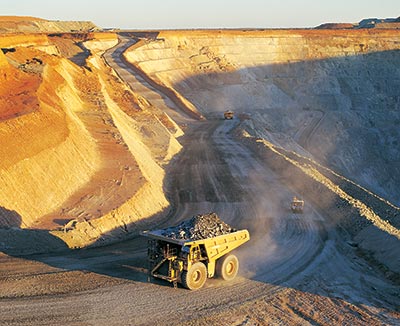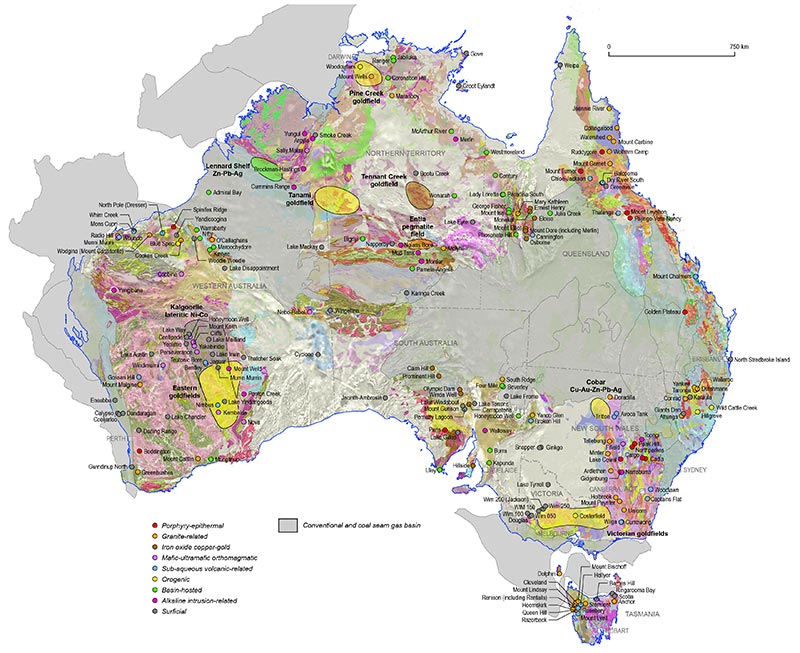2.1 A mineral systems framework for critical commodities
This content is being archived
Please be informed that this content is in the process of being archived. Please see our Legacy Publications page for further information.
The critical commodities discussed in this report differ from more broadly traded commodities such as Cu, Zn, iron ore and Au in that they are either traded, at present, to a very limited extent, or have a restricted resource and/or production base. Many critical commodities are produced as by-products and are recovered late during the metallurgical recovery process. In many cases, grades of these commodities are poorly constrained or unknown, resulting in highly uncertain resource estimates for Australia and the world. Reserve and resource data (both JORC-compliant or pre-JORC) are not available for many critical commodities (e.g., Te, Hg, As, Ga, In, Ge, Cd, fluorite and Se), and many critical commodities (e.g., As, Sb, Bi, Cd, Hg, Se and Te) attract penalties during the smelting of concentrates the major economic metal such as Ni or Cu etc.
Although mineral deposits have diverse characteristics in Australia and globally, these deposits can be related using temporal and genetic relationships, the tectonic setting in which they formed and the chemical characteristics of their host (and, hence, ore fluid) into a small number of mineral systems. Following the concept of a petroleum system (Magoon and Dow, 1994), Wyborn et al., (1994) defined a mineral system as 'all geological factors that control the generation and preservation of mineral deposits'.
Table 2.1.1 groups mineral deposits into nine broad mineral systems, including porphyry-epithermal, granite-related, iron oxide-copper-gold, subaqueous volcanic-related, mafic-ultramafic orthomagmatic, orogenic, basin-related, alkaline, and surficial. For each of these mineral systems, we summarise their characteristics and constituent deposit types, briefly describe important Australian examples and discuss potential to contain critical commodities. The locations of these deposits are shown in Figure 2.1.1.

A nickel mine in Western Australia.
Image courtesy of Thiess Pty Ltd.
| Mineral system (included deposit-types) | Tectonic/geodynamic setting | Geological setting | Redox state of metal-bearing fluids | Geodynamic driver | Fluid driver |
|---|---|---|---|---|---|
| Porphyry-epithermal (porphyry Cu-Au-Mo, low sulfidation epithermal, high sulfidation epithermal, skarn) | Convergent–magmatic arc | Volcanic-plutonic igneous province | Weakly oxidised to weakly reduced (∑H2S ∼ ∑SO4 to ∑H2S > ∑SO4); strongly oxidised (∑SO4 > ∑H2S) fluids in high sulfidation epithermal deposits | Change in subduction (direction, speed or dip angle) | Magmatism (magmatic fluids and/or convection of ambient fluids) |
| Granite-related (intrusion-related gold, intrusion-related Sn-W, porphyry Mo, pegmatitie rare metal, Rossing-type U?) | Convergent, generally inboard from arcs generally with post-collisional timing | Volcanic basin | Moderately to strongly reduced (∑H2S > ∑SO4 to ∑H2S >> ∑SO4) | Collision and accretion, change in subduction (direction, speed or dip angle) | Felsic magmatism (magmatic fluids and/or convection of ambient fluids) |
| Iron-oxide copper-gold (Olympic Dam-type IOCG, Andean-type IOCG, Cloncurry-type IOCG; Tennant-type IOCG) | Convergent, distal back-arc to within-plate; near craton margins | Pre-existing back-arc or continental rift basin host settings; volcanic-plutonic provinces | Both highly oxidised (∑SO4 > ∑H2S) and weakly to moderately reduced (∑H2S ∼ ∑SO4 to ∑H2S > ∑SO4) | Shift from contraction to extension | Mafic and felsic magmatism (convection of ambient fluids and magmatic fluids) |
| Mafic-ultramafic orthomagmatic (komatiite-associated Ni-Cu, mafic-ultramafic intrusion-hosted Ni-Cu, PGE and Fe-V-Ti) | Convergent–back-arc, divergent | All types of basin and basement | Not applicable | Change in subduction (direction, speed or dip angle), plate reorganisation, meterorite impact | Mafic-ultramafic magmatism |
| Subaqueous volcanic-related (volcanic-hosted massive sulfide, Broken Hill-type Zn-Pb-Ag) | Convergent–back-arc, divergent | Back-arc basin, transpressional basin, ensialic rift | Weakly to strongly reduced (∑H2S ∼ ∑SO4 to ∑H2S >> ∑SO4) | Change in subduction (direction, speed or dip angle), plate re-organisation | Magmatism (magmatic fluids and/or convection of ambient fluids–seawater) |
| Orogenic (lode gold, Cobar-type Cu-Au-Zn-Pb-Ag, Couer d'Alene Ag-Zn-Pb) | Convergent–collision and post-collision | Volcanic, back-arc, for-arc, platform/passive margin, rift, sag | Mostly reduced (∑H2S > ∑SO4) | Collision and accretion, change in subduction (direction, speed or dip angle) | Magmatism (magmatic fluids and/or convection of ambient fluids), topography; deformation, metamorphic devolatilisation |
| Basin-hosted (Mt Isa-type Zn-Pb-Ag, Mississippi Valley-type Zn-Pb, sediment-hosted Cu-Co-Ag, unconformity-related U, sandstone-hosted U, calcrete-hosted U, iron ore, phosphate, graphite) | Late convergent–back-arc, divergent, early basin inversion | (Rifted) passive margin, platform, ensialic basins | Mostly oxidised (∑SO4 > ∑H2S) fluids, although sedimentary precursors (banded iron formation, carbonaceous shale) form under mixed conditions prior to upgrading by later processes | Extension, plate reorganisation, basin inversion | Plate reconfiguration and shift in stress (extension to contraction or visa-versa); basin dewatering, convection, topography, tectonic pumping, post-orogenic magmatism |
| Alkaline intrusion-related (diamonds, REE deposits, peralkaline granite-related U-Th-REE) | Commonly within plate | All types of basin and basement | Unknown | Unknown | |
| Surficial (placers [Au, Sn, heavy minerals, diamond, paleoplacer Au-U], supergene upgrading [secondary Cu, non-sulfide Zn and Pb, bauxite, channel iron, lateritic Ni-Co], salt lake Li-K-B) | All | Regolith, all types of basins | Both oxidised (∑SO4 > ∑H2S) and reduced (∑H2S > ∑SO4) | Uplift, climate change | Topography (for placers), meteoric (for supergene upgrading) |

Figure 2.1.1: Location of individual mineral deposits and mineral provinces mentioned in text. The background is transparent surface geology draped over reduced-to-pole aeromagnetic data. The legend for the surface geology is presented in Figure 1.5.5.




